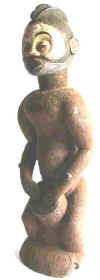 |
TRIBAL AFRICAN ART
NKANU (BAKANU, BANKANU, KANU, N’KANU)
Angola and Democratic Republic
of the Congo
The 5,000 Nkanu people live on the area bordering DRC and Angola and
are a part of eastern Kongo people. They are headed by family chiefs, called Fumu
Nakanda, who, in turn, report to local chiefs, known as Mfutu Mpu, each of whom
controls three to four villages. Like most of the peoples living in this region, Nkanu
peoples traditionally observed matrilineal descent, inheritance rites, succession, and
residence patterns.
Among Nkanu, men contribute to the local economy largely through
hunting. They may hunt either individually or in groups, and most often use bow and arrow,
or old rifles. The women contribute primarily through cultivation of cassava, sweet
potatoes, beans and peanuts. They further supplement the diet through the gathering of
wild fruits and berries and occasional fishing in the nearby rivers. Manioc is the main
staple throughout the region, but maize is also very important. Intergroup trade with
neighbors in the region play a critical role in Nkanu economics.
They believe in the creator God who inhabits the sky and is
responsible for life, death and all unanswerable questions. There are no religious
practices, which actively pay homage to this God. Instead, religious celebrations focus on
honoring the elders and ancestors. The death of an elder is cause for a public ceremony
performed by other elders. Ancestors may be honored by recognizing and practicing the
traditional ways and through offerings and gifts. The offering place is usually a clearing
in the forest, removed from the everyday interactions of village life. Offerings may
otherwise be made at the gravesite of the ancestors.
The Nkanu organize initiation rites for boys and young men. These
rites, called nkanda or mukanda, take place over several months at the age
of puberty. A dominant theme of the ritual is the symbolic death and rebirth of the
individual who begins nkanda as a child and re-enters society at the conclusion of
the rite as an adult. Initiates live in a specially constructed enclosure situated outside
the community. Physical and psychological changes take
place as the initiates are circumcised, acquire specialized knowledge, and learn the
skills necessary for adult life.
Sculptors who are also ritual specialists well versed in the
esoteric knowledge and symbolic visual language of nkanda arts produce the works.
During initiation, the youths observe the creation of masks, figures, and carved panels,
most of which are destined for public display at the conclusion of the initiation cycle.
Thus, by observation--and perhaps by helping carvers in small tasks--Nkanu initiates learn
about the forms, designs, and meanings of initiation arts. An elaborate celebration at the
conclusion of nkanda reintroduces the initiates to the community as adults. During
this period of intense artistic activity, specialized wood sculptors create wall panels,
carved in high relief, with images of men, women, and animals.
The types of artifacts produced by the Nkanu were influenced by the Kongo and the Yaka, but they achieved a distinctive style through the use of applied polychrome pigments. Typical for the Nkanu statues is a circular line around the eyes while their large initiation masks have bulging eyes and inflated cheeks.